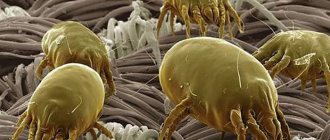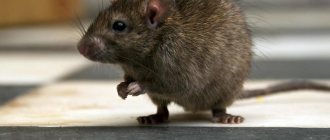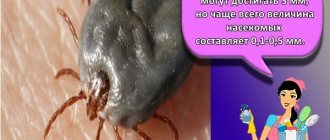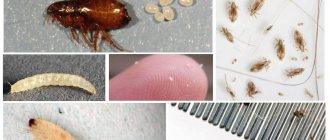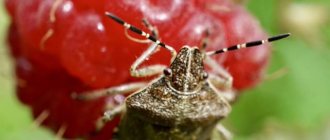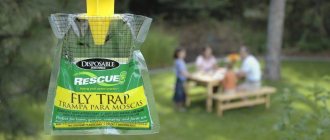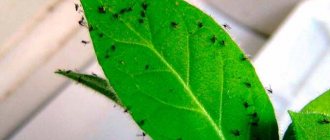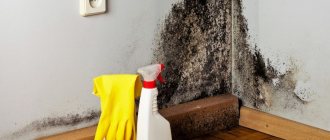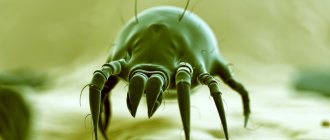Many housewives are interested in the question: where does dust come from? Even the constant presence of cleanliness in the home will not get rid of it.
In any home there are textile items, books and newspapers, and other paper products that can cause dust particles to appear.
And to this add ventilation and air conditioning of the apartment. Residents come and go, bringing with them dust from outside.
This is the result: a thin layer of disorder appears on any surface. But we are interested in dust mites, which can live in the thickness of this very dust.
Dust mites under a microscope
What are they and what harm do they cause to humans, and even more so how to deal with them if parasites suddenly appear.
Features of dust mites
Dust mites are arachnid insects that are invisible to the naked eye, so determining their presence in your apartment is problematic without much research.
But it’s worth noting that if any resident shows signs of allergies, then you shouldn’t rule out dust mites as the cause. What you need to know about the parasite?
Distinctive features
A special difference from other insects is the size of the pest. It is usually between 0.1 and 0.5 mm, it is even less than a millimeter, so it is not visible.
Pyroglyphid or dermatophagoid mites, which belong to the arachnid family, live next to humans.
The smallest arthropods survive in any conditions and layers of dust, but room temperature and high humidity are preferable for them.
Not only dust on shelves, but also other hard-to-reach places can become their habitat:
- Home textiles: pillows, mattresses, curtains. Ticks can live in closets where old unnecessary things and trash that has not been sorted out for a long time are stored.
- Paper products - books in huge libraries, because not every owner will sort through all the volumes of numerous subscriptions and wipe them. Sometimes old photos and newspapers are stored under beds, in closets and other secluded places, which is also a favorite environment for the parasite mite.
- The pile of carpets, rugs, and carpet runners can be infested with pests. He is not averse to living in soft toys, woolen blankets, rugs, etc.
- Hard-to-reach places: floor corners and baseboards behind tightly pushed cabinets, under the bed, sofa, refrigerator, where it is difficult to walk with a mop every day.
The peculiarity of the tick is that it does not bite its victim, but feeds on dead skin particles and fallen human hair.
Dust mite in carpet
But what then causes allergies? This is feces that the tick produces into the environment and contains a protein sensitive to the human body.
Complications that may arise from dust mites for residents of the house:
- bronchial asthma;
- atopic dermatitis;
- allergic rhinitis;
- conjunctivitis.
Serious illnesses are accompanied by milder symptoms: the flow of tears, sneezing, itching, sore throat, increased fatigue and headache.
Consequences of dust mites in bed
In any case, if symptoms of such diseases are detected, it is necessary to consult a doctor in order to identify the cause and begin to solve it before serious consequences occur.
Reproduction and life cycle
The full life cycle of one tiny parasite averages from 2 to 3 months. During this period, the female is able to lay up to 60 eggs.
Important! Low ambient temperature slightly inhibits their reproduction, but raising it to 25 degrees and increasing humidity to 70% accelerates the reproduction process. Under these conditions, the concentration of the parasite per 1 g of dust was calculated to be more than 10 thousand individuals. And for the first symptoms of an allergic reaction to appear, only half a thousand copies are enough.
Bed mite: photo
Bed mites, also called dust mites and linen mites, pose a serious danger to humans because the bites of linen and bed bugs can cause severe allergy symptoms and aggravate health conditions.
The habitat and breeding area for linen mites, which are microscopic parasites, is mainly bed linen, which must be washed regularly to get rid of the parasites themselves and their feces. It is necessary to regularly wash not only bedding, but also mattresses, children's soft toys, carpets and other products in which the female linen mite can lay eggs, after which entire populations of the pest appear. Although the symptoms of bites from microscopic individuals of furniture and bed mites are also difficult to see with the naked eye, parasite excrement, as well as some other signs, will be clear confirmation that pests live in the house, lay eggs, reproduce and lead active life activities, representing real household pests and household allergen.
Pests feed on microscopic particles of human skin, so populations of feather mites prefer to live in bedding and things hidden in closets. If feces of dust microscopic arachnid scabies mites are detected or allergic symptoms appear, you should immediately carry out a wet cleaning of all rooms, trying to identify places where parasites and arachnid populations accumulate. To destroy dust mites, linen mites, bed mites and bed bugs, as well as other parasites, it is important to use only effective drugs, because mites are paratic and prefer to bite a person at any time and in any place.
How to get rid of dust mites at home
If such parasites and serious consequences are identified, then, of course, methods have been developed to combat them, which we will now describe.
Cleaning
Regular cleaning is the key to cleanliness.
Cleaners
In addition, the key to defeating the enemy is finding the optimal humidity and temperature.
- In order to regulate humidity, you can use a dehumidifier. Dry air blocks the parasite from multiplying.
- Regular ventilation also helps reduce condensation in the room. To this condition it is necessary to add the best temperature for a person. It can range from 16 to 22 degrees.
- The best way to deal with dust is wet cleaning twice a week. The absence of dust in the house will help eliminate the mite faster.
For cleaning, take a large soft cloth that absorbs moisture well. Every time after wiping contaminated surfaces, rinse it in hot water. In addition, the large size of the fabric will not allow dust to rise into the air, but will settle on it. Every time, after each cleaning, the rag must be thrown away.
Many housewives advise preparing a special solution that can be used to treat any surface, carpets, walls, upholstered furniture.
Cleaning soft surfaces with a vacuum cleaner
To prepare it, you need to take a couple of glasses of water and stir about 10 (2 tsp) tea tree oil into them. Pour this solution into a bottle and spray with a spray bottle.
Important! Before each treatment, the bottle must be shaken to mix the oil inside the vessel. Allergy symptoms will subside within a couple of weeks.
As an alternative to such a solution, you can buy any anti-dust mite product on the industrial market.
Clean out your closet with old things. Throw away the unnecessary ones, wash the rest in a hot wash, especially for bed linen, since parasites live in mattresses and pillows.
Reduce the number of decorative pillows or buy special tick covers from the store. Take silk items and soft toys out into the cold to kill the enemy.
Keep an eye on your indoor plants, as they are also a source of dust. Spray them, wash each leaf, monitor the humidity in the flower pot.
They should not be too dry, but also too waterlogged. If possible, reduce them to a minimum.
If there are pets in the house, make sure that there is no hair or fluff left behind. This is an excellent food for dust dwellers. Clean carpets using a vacuum cleaner with various attachments.
Cleaning up pet hair
Today you can even buy a special mitten that can easily get rid of shed hair.
Cleaning does not mean walking with a damp cloth. The main thing is to look into every corner and restore order there.
Get rid of unnecessary newspapers, things, broken appliances, which are additional dust collectors in your apartment.
Chemicals
If it is not possible to restore order, it may be bad weather (winter, rainy autumn), then seek help from specialized chemical preparations against dust mites.
- Allergoff - sold in the form of a spray that destroys all individuals, as well as their excrement and waste products.
- All-Rug is a soap product for washing various surfaces and cleaning carpets.
- X-MITE is a substance presented in the form of a powder for dry cleaning of carpets, upholstery and mattresses.
- Acaryl is a liquid substance that works well against ticks even when added to the washing machine.
Your health depends on which product you choose, expensive or not. Before choosing, consult the seller and read the instructions.
Traditional methods
Harmful inhabitants of dust have appeared and have existed for a long time, but no special instructions have been identified among folk sorcerers and witches for eradicating dust mites.
Still, there is a special recipe that still works today.
Important! In 1 liter of ordinary water, 1 glass of salt is thoroughly dissolved. This solution is used for general cleaning of the living area.
It’s not complicated, and nowadays you can figure it out, but for some reason it’s considered ancient. Dissolved salt can destroy all pathogenic bacteria and viruses, especially allergens.
Ways to fight
It is impossible to eradicate dust mites once and for all, but it is important to use the methods described below to reduce their population and minimize the negative consequences of their activity. In the fight against arthropods, an integrated approach is important: you need to create conditions unfavorable for the parasite and consult a doctor to relieve allergy symptoms.
Thorough cleaning
Cleanliness is unbearable for the dust-loving arthropod. Regular wet cleaning significantly reduces the number of pests. It is recommended to wash surfaces on which dust accumulates once or twice a week with a salt solution (a tablespoon per 2 liters of water). There are six more tips to help create an environment unfavorable for ticks.
- Modern vacuum cleaner. Vacuum cleaners with an aqua filter are an excellent solution that will help eliminate both mites and their waste products.
- Cleaning “dust collectors”. If it is not possible to completely abandon carpets, upholstered furniture, tablecloths and curtains, regular cleaning is necessary. To do this, they need to be knocked out, vacuumed, treated with a steam generator, or used dry cleaning services.
- Thermal impact. Pests die at high and low temperatures. Therefore, everything that is possible should be washed in a washing machine at a temperature of 65°C or more. Anything that cannot be washed should be placed in the freezer overnight, first wrapped in a plastic bag.
- Daily ventilation. The circulation of air currents creates a temperature and humidity that is favorable for humans, but destructive for the pest.
- Updating pillows and mattresses. The interior contents of bedding should be washed or changed regularly. It is important to consider the shelf life of the product; depending on the material, it can range from two to five years, after which you need to get rid of the pillow or mattress.
- Handling books and dishes. All books should be regularly wiped with a damp cloth, and dishes should be doused with boiling water.
When cleaning, you must wear a protective mask and rubber gloves and wear clothing that completely conceals your body.
Inspection of household items
It is recommended to replace bed linen with synthetic ones: this texture is not as attractive to parasites as natural fibers. It is also better to choose bedding with synthetic filling over down pillows and blankets. In addition, it is recommended:
- purchase furniture upholstered in leather or leatherette;
- get rid of carpets;
- throw away soft toys.
It is advisable to give away the books or at least put them in locked cabinets.
Special means
Preparations that get rid of dust mites are called acaricides. The table below will help you get an idea of the popular products.
Table - Purchased anti-dust mite products
| Name | Active components | Peculiarities |
| Allergoff spray | — Benzibenzoate; - permethrin; - pyriproxyfen | — Used to treat any surfaces; — safe for people and animals; — neutral smell; - leaves no traces; - has no contraindications |
| Acaril laundry detergent | - Tea tree oil; - alcohols; — surfactants; - methyl salicalate | — Harmless to health; — safe for colored fabrics; — neutralizes allergens; - eliminates pests |
| Spray "Milbiol" | Melia indian seed oil | — Harmless to people and animals; — wide spectrum of action; - used for processing items that cannot be washed |
| Aerosol "Akarosan" | Benzyl benzoate | — Used for processing upholstered furniture and other surfaces; — safe for humans; - long lasting effect |
| Easy Air Spray | — Deionized water; - anti-allergenic additive; - nonionic surfactants | — Environmentally safe, does not pollute the environment; - cannot be used on painted or polished surfaces |
Most anti-dust mite medications are safe for humans. However, if undesirable reactions are observed during the use of the product, it is recommended to find an alternative.
Useful technology
The fight against dust mites is greatly simplified by the use of special equipment. There are four useful devices.
- Air Dryer. Allows you to maintain a level of humidity that is detrimental to the development of the parasite.
- Ozonizer. Used to treat bedding. You need to lay out the bed, turn on the device and leave the room while it is working, since the concentration of ozone released is dangerous for humans.
- Air purifier. You should choose either photocatalytic (the oxidizing agents it produces kill arthropods) or with a UV lamp (the disinfecting effect of ultraviolet radiation is detrimental to pests).
- Repeller. The device connects to the network and generates ultrasonic waves, imperceptible to humans, but extremely uncomfortable for parasites. Pests try to stay away from the source of the “noise”.
"Grandmother's" methods
Supporters of folk remedies recommend cleaning carpets and rugs with snow in winter. Here are three more “grandmother’s” methods.
- Strong saline solution. Mix sodium chloride in warm water, maintaining a ratio of 200 g per liter. Use the solution to treat areas where dust accumulates. Repeat the procedure one to three times a week.
- Sunbathing. During the hot season, hang bedding, clothes and carpets in the sun: under the influence of ultraviolet radiation, the parasites will die.
- Eucalyptus oil. Stir 15-30 drops in 400 ml of distilled water. All items that cannot be washed should be sprayed with the solution and dried in a dry, warm place. Repeat three to four times, performing the procedure every other day.
You should not use eucalyptus oil if there are children under ten years of age in the house.
Medicines
Treatment for dust mite allergies is complex. Usually nasal and corticosteroid drugs are prescribed in combination with antihistamines:
- "Diazolin";
- "Cetrin";
- "Suprastin".
Only a doctor can prescribe treatment based on the results of a thorough examination.
ASIT - allergen-specific immunotherapy. The only method to eliminate the cause of allergies. The essence of therapy is the introduction of gradually increasing doses of the allergen. In case of allergy to dust mites, the drug “Staloral Mite Allergen”, produced in the form of sublingual drops, is used. There are contraindications.
Preventing dust mites
To keep the hordes of harmful parasites that are poisoning your life under control, the following simple rules will help:
- Regular cleaning using various cleaning solutions and pest control chemicals.
- Optimization of moisture levels in the air and temperature conditions.
- If there is a possibility of a tick appearance, it is important not to litter the space. Wash clothes in hot water in a timely manner, and take large items out into the cold.
- Once every five years, replace old pillows with new ones, and dry-clean mattresses.
When the population has grown and there are signs of deterioration in health, seek medical help and have a doctor prescribe antihistamines to improve your health.
Cleaning the premises
Cleanliness in the house is a guarantee that dust mites will not settle here, but if they already exist, then cleaning will help reduce their number.
Without food, ticks will die, so you need to clean the house of dead particles of human and pet skin:
- wash bed linen, clean mattresses, blankets and pillows;
- wipe the furniture, not forgetting hard-to-reach corners;
- wash the floor, remove all dust;
- treat outerwear, carpets and even soft toys; mites can live in them;
- Wash your pets with a special shampoo.
A steam cleaner will be effective in the fight against ticks - high temperature will help kill the ticks.
There are things that cannot be washed, in which case take them to the dry cleaner, and under no circumstances leave them! Removal of dust mites must be complete; even a few parasites can multiply and restore their population in the house in the future.
How to Diagnose Allergic Rhinitis
To identify allergic rhinitis, it is necessary to collect an allergic history:
- quality of living conditions, presence of mold in the apartment (house), presence of pets, house dust collectors;
- does the manifestation of the disease depend on seasonality;
- what is the situation in which the symptoms of the disease occur (in nature, in a damp room, etc.);
- is there a clear temporal relationship between allergen exposure and exacerbation;
- is there any improvement after stopping contact with the suspected allergen.
Currently, there are a number of methods for laboratory diagnosis of the disease that help to create a complete picture and make an accurate diagnosis. Laboratory diagnostics includes the following methods:
- clinical blood test;
- X-ray of the nasal cavity and sinuses;
- skin tests and provocative nasal texts (allergy testing);
- cytological examination of nasal secretions;
- examination of nasal discharge for the presence of microflora;
- anterior rhinoscopy;
- endoscopic examination of the nasal cavity;
- computed tomography of the nasal cavity and paranasal sinuses;
- anterior rhinomanometry.
WHAT TO DO AFTER REMOVAL OF A TICK?
In people predisposed to allergies, a tick bite can cause a strong response in the body. Facial swelling often develops, difficulty breathing and muscle pain appear. In this case it is necessary:
- give the victim an antihistamine: Suprastin, Claritin, Zyrtec;
- provide access to fresh air, unbutton clothes;
- Call an ambulance.
All other diagnostic and treatment measures are carried out only in a hospital setting.
You can submit a tick for analysis in Tosno at the ETALON medical center at Lenin Ave., building 3. The center is open seven days a week and on holidays.
If the tick could not be preserved, for early diagnosis of the disease it is recommended to donate blood to detect immunoglobulins for infections. The analysis is carried out quickly, the result is usually ready within 24 hours. If you have been vaccinated, you must indicate the date when donating blood. The presence of vaccine antibodies may confuse health care providers.
DISEASES CAUSED BY TICK BITE
So, why is a tick bite dangerous for humans? Infections carried by bloodsuckers can be microbial, viral, rickettsial or protozoal in nature. All of them cause serious illnesses, often resulting in disability and, in rare cases, death. The cause of irreparable disorders in the body is late detection of the parasite and untimely therapy.
For Russia, the most significant diseases from tick bites are tick-borne encephalitis, Lyme borreliosis and zoonotic infections. Let's look at them in a little more detail.
Tick-borne encephalitis
The main carrier of this disease is the ixodid tick. In the wild, the pathogen circulates between bloodsuckers and small animals, usually rodents and birds. In areas developed by humans, livestock—cows and goats—become an additional reservoir. The causative agent of tick-borne encephalitis persists in parasites for a long time and passes to the offspring through eggs.
Attention. The virus is transmitted through a tick bite. Transmission of the pathogen through the alimentary route is often recorded - through infected cow's or goat's milk that has not been boiled.
Asymptomatic disease is very common and can reach 85–90% in some areas. Prolonged blood sucking significantly increases the risk of developing pronounced forms of pathology. The virus tolerates low temperatures well, but dies fairly quickly when heated to 80 °C.
Infection with tick-borne encephalitis is seasonal. The first peak of the disease occurs in May-June, the second is recorded in August - early September.
During a bite, the pathogen immediately enters the human blood through the salivary glands of the tick, where it is found in the greatest concentration. After a few hours, the virus penetrates the victim’s central nervous system, and after 2 days it can be detected in brain tissue. The incubation period for encephalitis from a tick bite is 14–21 days, and when infected through milk - no more than a week.
Tick-borne encephalitis
Symptoms of tick-borne encephalitis
The majority of victims have an asymptomatic form of infection, and only 5% have a pronounced form of infection. Tick-borne encephalitis most often begins suddenly with the following symptoms:
- increased body temperature to 39-40 °C;
- Strong headache;
- sleep disturbance;
- nausea leading to vomiting;
- diarrhea;
- redness of the skin of the face and upper body;
- weakness, decreased performance.
Such symptoms are characteristic of the febrile form of the disease, which disappears after 5 days. There is no damage to the central nervous system in this case.
Meningeal and meningoencephalitic forms of pathology are much more severe. The patient complains of lethargy, apathy and drowsiness. Hallucinations, delirium, impaired consciousness, and convulsions similar to epileptic seizures appear. The meningoencephalitic form can be fatal, which is very rare in recent years.
Periodic muscle twitching indicates damage to the peripheral nerves. A polyradiculoneuritic form of encephalitis develops, in which general sensitivity is impaired. With the polioencephalomyelitis form of the disease, paresis of the arms and legs is observed.
Lyme disease (Lyme borreliosis)
Borreliosis is common in the northern regions of Russia. The pathogen enters the human bloodstream when bitten by ixodid ticks and can persist in the body for years. The first symptoms of the disease include:
- headache;
- temperature rise to 38-39 °C;
- fatigue, weakness and apathy.
1–3 weeks after a tick bite, a thickening and ring erythema appear at the site of suction, which can reach 20–50 cm in diameter.
Attention. Despite the fact that a few weeks after the bite the red spot disappears without a trace, it is necessary to test for the presence of the causative agent of Lyme borreliosis, since the disease has serious complications and can be transmitted from a pregnant woman to a child.
Often the central nervous system, heart, muscles and ligaments, joints and organs of vision are involved in the pathological process. Late diagnosis and untimely therapy can lead to chronic borreliosis, which often ends in disability.
Lyme disease
Ehrlichiosis
The disease is also transmitted by ixodid ticks. Deer are considered the main reservoir of Ehrlichia, with dogs and horses serving as intermediate reservoirs.
The virus enters the human body during a bite through the parasite's saliva. The incubation period can be up to 3 weeks, and the acute form of the disease lasts 14–21 days. In some cases, the pronounced phase drags on for up to 6–8 weeks.
Ehrlichiosis can be asymptomatic or clinically pronounced, even fatal. Common signs of the disease include:
- fever;
- increased sweating;
- weakness, drowsiness;
- nausea to the point of vomiting;
- rigor.
In the acute phase of ehrlichiosis, anemia and a decrease in the level of platelets and leukocytes in the blood are observed.
Relapsing tick-borne typhus
The infection is usually recorded in southern Russia, Armenia, Uzbekistan, Tajikistan, Georgia and Kyrgyzstan. The disease always occurs suddenly and begins with a vesicle at the site of the tick bite. Then other symptoms are added to the skin manifestations:
- fever;
- increased body temperature;
- aching joints;
- nausea and vomiting;
- headache.
Gradually, the bubble becomes bright red, a pronounced rash appears on the patient’s body, the liver enlarges, the skin and whites of the eyes turn yellow.
The disease is wavy in nature. The acute phase usually lasts from 3 to 5 days, then the victim’s condition returns to normal and the temperature drops. A few days later everything repeats again. There can be many such attacks. Each subsequent one occurs with less severity.
Relapsing tick-borne typhus
Coxiellosis
It is one of the most common zoonotic infections in the world. The disease can be transmitted by both farm and wild animals. One of the distributors of the pathogen is the tick, most often the ixodid tick. It is capable of maintaining rickettsiae in the body for a long time and transmitting them to offspring. The first symptoms appear 5–30 days after the tick bite:
- increased sweating;
- elevated temperature;
- dry, exhausting cough;
- loss of appetite;
- redness of the face and upper body;
- migraines, weakness and drowsiness.
KU fever is often accompanied by pneumonia, pain in the lower back and muscles. The temperature in the first days of the disease can change several times during the day. This disease can only be treated in a hospital setting; it responds well to therapy and recovery occurs quickly. Complications are rare, and the outcome of the disease is most often favorable. A person who has recovered from coxiellosis develops a strong immune system.
Forms of allergic rhinitis
Doctors distinguish mild, moderate and severe forms of rhinitis.
In the first case, the symptoms are mild, quality sleep, daily quality of life and activity are preserved, and the general condition can be called satisfactory.
In the second case, the symptoms already affect all of the above points. A person is more susceptible to exposure to allergens and experiences discomfort.
When the disease is severe, the symptoms become so painful that the human body cannot function normally.
According to the forms of its course, allergic rhinitis can be intermittent (symptoms persist only up to 3 days a week and up to 4 weeks a year) and persistent (symptoms persist more than 4 days a week and more than 4 weeks a year).
The disease itself can be detected both during an exacerbation and during remission.
RULES OF CONDUCT IN CASE OF A TICK BITE
So, what to do if you are bitten by a tick? First of all, it is necessary to remove the bloodsucker as soon as possible. This should be done slowly and carefully so as not to damage it or cause infection. Do not use gasoline, nail polish or other chemicals. Vegetable oil or fat will not help either. It is better to use effective and practice-tested methods.
Removing a tick with a thread
The method is simple, but requires a lot of dexterity and patience. It will be useful when extracting large specimens. For the procedure to be successful, it is recommended to perform the following steps:
- Take a long and strong thread
- Tie a loop at the border between the skin and the body of the parasite and carefully tighten it.
- Using rotating, rocking and pulling movements counterclockwise, slowly remove the tick.
The removed bloodsucker must be placed in a glass container with a tight lid and taken to the laboratory for research.
Removing a tick using tweezers
Another simple way to get rid of a tick. Using tweezers you can remove a bloodsucker of any size. The basic manipulations are similar to the thread pulling option. It is better to use tweezers with flat edges, grabbing the parasite at the very base. Then, using careful rotational movements, remove the tick and disinfect the wound.
Attention. When removing the bloodsucker, tweezers must be held strictly parallel or perpendicular to the skin.
It is better to use tweezers with flat edges, grabbing the parasite at the very base.
Tick twisters
Not long ago, the pharmaceutical industry began producing special devices for removing the parasite. The kit includes two tools - a large one and a small one for pliers of different sizes. Using a twister, you can quickly and effectively remove the parasite without damaging it.
The kit includes a test tube into which it is recommended to place a live parasite and store it in the refrigerator for further research.
Other ways to remove ticks
If there are no devices nearby when a tick bites you, you can try to pull the parasite out with your hands. The method is risky, but if you do everything correctly, the result will be good. In this case, you must adhere to the following recommendations:
- Wrap your fingers in a handkerchief or gauze to make it easier to hold the tick.
- Grab it at the very border with the skin and pull it out with smooth twisting movements.
- Disinfect the wound or rinse with water.
If for some reason the tick cannot be preserved for analysis, it should be destroyed by pouring boiling water over it or burning it over a fire.
You can often hear advice from “experienced” people on how to remove a bloodsucker using oil. Despite its apparent simplicity, the method is not only useless, but rather harmful. The parasite, sensing a threat to life, will relax its proboscis and regurgitate the contents of the stomach along with the pathogens back. At the same time, the risk of infection will increase sharply.
Attention. If you cannot remove the bloodsucker yourself, you must contact a medical center.
Medical workers will provide first aid in case of a tick bite: they will professionally remove it and send it for examination, they will disinfect the wound and tell you what to do next. The specialist will definitely inform you what symptoms you should pay attention to in the next month.
How to treat allergic rhinitis
Three main methods are used to treat the disease:
- non-medicinal (removal of allergens),
- medicinal (using various drugs),
- surgical.
The first two methods are discussed in detail in the previous paragraph, and now we will talk about the third.
Surgical intervention is performed in three cases: when non-drug and drug treatment methods do not help, when correction of structural disorders of the nasal cavity and paranasal sinuses is needed, when pathologies appear (purulent or polypous sinusitis, etc.). This method is distinguished by its accuracy, the ability to penetrate any part of the nose and sinuses where surgery is necessary, functionality and efficiency. If the operation is performed in a timely manner, recovery and return to a full life occurs quickly and without serious complications.
Important: operations are performed with complete exclusion of contact with the allergen. The procedure is not carried out during flowering or other active exposure to allergens.).
After surgery, scars, osteomyelitis, empty nose syndrome, facial pain, bleeding, and atrophic rhinitis may occur.
In addition to surgical intervention, laser coagulation (cauterization) of the nasal turbinates is also performed (submucosal, targeted, selective ablation of hypertrophied areas).
Among the most effective drugs for the treatment of sinusitis symptoms are
Sialor Rhino based on silver ions. It has an anti-inflammatory effect and prevents the proliferation of bacteria. Thanks to the mild action of the drug, the balance of microflora is maintained and favorable conditions are created for the regeneration of the nasal mucosa.
SIGNS OF A TICK BITE
Most often, an attached parasite is not noticed immediately. Several hours pass before the victim begins to feel unwell and decides to examine himself. The first symptoms of a tick bite in a person are as follows:
- there is weakness, a desire to lie down;
- chills and fever occur, possibly an increase in temperature;
- photophobia appears.
The dynamics of the signs depends on the number of attached parasites and the characteristics of the victim’s body. The symptoms of a bite are especially pronounced in the elderly, children and those suffering from allergic reactions or immunodeficiency pathologies.
Attention. In people of this group, symptoms may be supplemented by low blood pressure, increased heart rate, itching, headache and enlargement of nearby lymph nodes.
In rare cases, difficulty breathing and hallucinations may occur.
Temperature after a bite as a symptom of the disease
An increase in body temperature in the first hours after a tick bite most often does not indicate anything serious. This is how an allergic reaction to the bloodsucker’s saliva manifests itself. You should be wary if fever appears a few days after the parasite has been ingested. This reaction of the body may indicate the onset of the disease.
Each infection caused by a bloodsucker bite has its own characteristics:
- With tick-borne encephalitis, relapsing fever appears. The first rise in temperature is recorded 2–3 days after the bite. After two days everything returns to normal. In some cases, a repeated increase in temperature is observed on days 9–10.
- Borreliosis is characterized by fever in the middle of the disease, which is accompanied by other symptoms of infection.
- With monocytic ehrlichiosis, the temperature rises 10-14 days after the tick bite and lasts about 3 weeks.
Almost all diseases transmitted by bloodsuckers are accompanied by fever.
Symptoms
The disease is manifested by several symptoms: itching of the mucous membranes, sneezing, watery nasal discharge (rhinorrhea), and nasal congestion, and sometimes even conjunctivitis. With obstruction (obstruction syndrome of the human respiratory system), headaches often occur. Allergic rhinitis can lead to complications such as sinusitis.
The causes of rhinitis can be pollen, mold spores, wool, fluff and waste products of animals (cats, dogs, rodents), dust mites, cockroaches.
Asthma is a frequent accompaniment of allergic rhinitis, but it is not yet clear whether a false runny nose is the cause of asthma or whether both of these diseases are based on the same cause - the allergic process. With asthma accompanying hay fever, the patient may experience shortness of breath and a severe cough.
